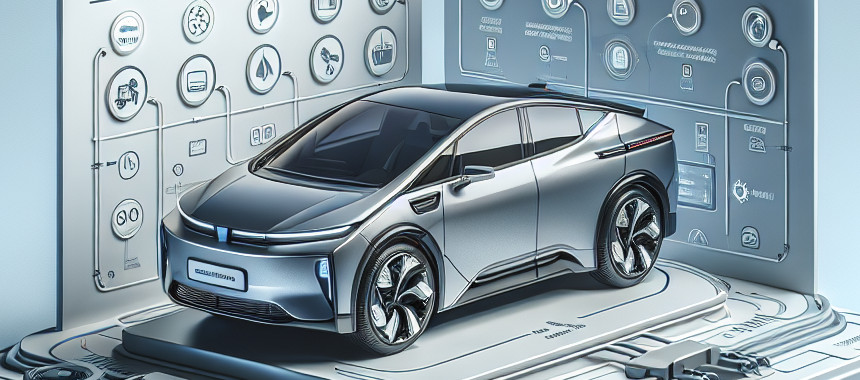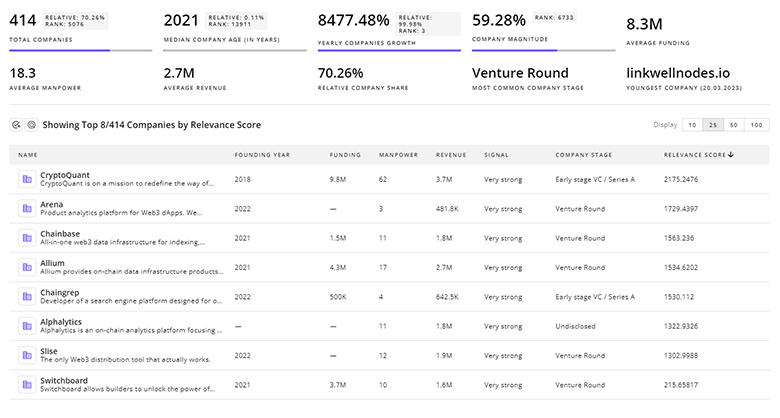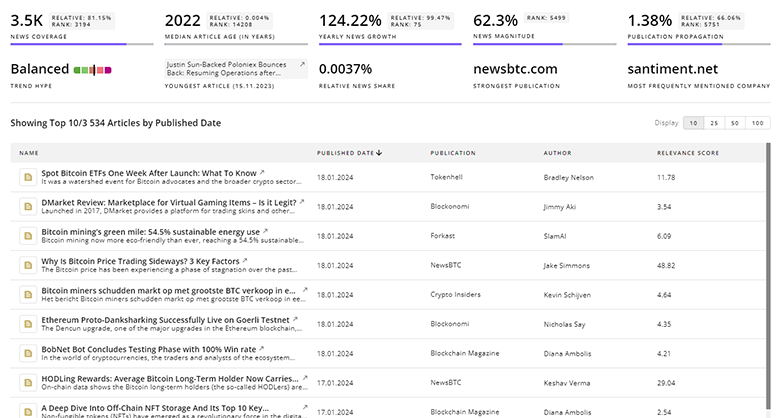
Plug-in Hybrid Report
: Analysis on the Market, Trends, and TechnologiesThe plug-in hybrid market shows clear commercial momentum: global market size reached USD 27.8 billion in 2024 with a projected CAGR of 13.3% through the coming decade, pointing to a USD 58.9 billion market by 2030. Short-term sales data confirm the momentum—PHEV volumes rose 27% year-on-year in Q1 2025, led by a 37% increase in China—validating that policy windows and regionally concentrated manufacturing capacity currently drive the fastest growth pockets in the sector.
The last time we updated this report was 58 days ago. If there’s something missing or off, your tips are welcome!
Topic Dominance Index of Plug-in Hybrid
The Dominance Index for Plug-in Hybrid merges timelines of published articles, newly founded companies, and global search data to provide a comprehensive perspective into the topic.
Key Activities and Applications
- Urban commuter electrification — PHEVs supply electric-only range for daily trips while preserving gasoline range for longer journeys, making them practical for mixed-use drivers and two-car households.
- Fleet decarbonization and TCO optimization — commercial fleets adopt PHEVs where charging infrastructure or duty cycles make full BEV adoption expensive; fleet planners use software to model total cost of ownership and charging needs Volteum.
- Retrofit and conversion programs — retrofit kits convert existing ICE or hybrid vehicles into plug-in hybrids, enabling rapid emissions reductions from the in-use fleet without full vehicle replacement Blue Dot Motorworks.
- Kerbside and shared charging for urban residents — solutions that enable safe, permitted charging for street-parkers remove a major adoption barrier for city households lacking private parking Kerbo Charge and Coul St.
- Intelligent charge orchestration and V2X pilot deployments — software platforms manage load, align charging to low-price periods and solar surpluses, and enable vehicle-to-home or vehicle-to-grid services where hardware supports bidirectional flow Pleevi; Chargerly.
Emergent Trends and Core Insights
- China remains the volume engine — China's PHEV share expanded rapidly (notably strong growth in 2024–2025) and supplied a major portion of global EV volumes, so competitive dynamics and component sourcing remain China-centric for now.
- Policy timing creates demand spikes — trade-in incentives and expiring tax credits produce concentrated purchase windows; OEMs and retailers plan promotions and inventory around these policy cliffs to capture near-term volume.
- Software and energy orchestration are differentiators — AI-driven scheduling and site-level load management allow sites to install more chargers without grid upgrades, improving economics for property owners and fleets; platforms that combine forecasting, dynamic tariffs and local solar yield measurable TCO gains.
- Battery lifecycle management moves from niche to strategic — battery-health reporting, second-life repurposing and diagnostics reduce residual-value risk for buyers and fleets and unlock circular-economy revenue streams Recurrent
- Charging accessibility, not peak power alone, will gate adoption — analyses and field pilots show that solving the kerbside and multi-dwelling charging problem will unlock many urban buyers who otherwise cannot adopt electrified vehicles Coul St; visual market share data show PHEV penetration rising but remaining sensitive to infrastructure access.
Technologies and Methodologies
- AI-driven smart charging and load management — algorithms predict departure times, solar production and price signals to schedule charging at lowest system cost and to expand per-site charger density without grid reinforcement.
- Bidirectional (V2G/V2H) hardware and control stacks — high-efficiency bidirectional wallboxes and V2X orchestration enable vehicles to act as distributed storage assets and to monetize flexibility where markets or aggregators exist sun2wheel.
- Modular retrofit powertrains and conversion kits — standardized bolt-on systems let operators electrify fleets and vintage vehicles faster and at lower CAPEX than bespoke conversions Current EV Motors.
- Battery diagnostics, non-invasive scanning and second-life integration — CT/X-ray and software analytics identify pack faults early and grade battery packs for reuse in stationary storage, improving resale confidence and lowering lifecycle costs INNER
- Scaled charging-as-a-service and BaaS (battery leasing/swapping) methods — in high-utilization segments (two-wheelers, last-mile fleets), swapping and leasing reduce upfront cost and increase vehicle uptime Indofast Energy.
Plug-in Hybrid Funding
A total of 399 Plug-in Hybrid companies have received funding.
Overall, Plug-in Hybrid companies have raised $4.6B.
Companies within the Plug-in Hybrid domain have secured capital from 585 funding rounds.
The chart shows the funding trendline of Plug-in Hybrid companies over the last 5 years
Plug-in Hybrid Companies
- Blue Dot Motorworks — Blue Dot builds retrofit PHEV systems that convert existing vehicles into plug-in hybrids, targeting fleet operators and owners who want electric-first daily range without replacing vehicles. Their retrofit approach lowers CAPEX compared with new-vehicle replacement and shortens deployment lead time, making emissions reductions implementable at scale.
- Pleevi — Pleevi supplies an AI charging-optimization API focused on professional sites and fleets; it plans charging around solar, dynamic tariffs and departure times to minimize energy cost and grid impact. The technology targets the value layer that lets owners add chargers without expensive grid upgrades, improving site economics.
- Chargerly — Chargerly develops bidirectional chargers and V2X infrastructure aimed at multi-unit housing and managed fleets, positioning vehicles as dispatchable energy assets. Their emphasis on bidirectional hardware plus orchestration software targets revenue generation through flexibility markets and improved building self-consumption.
- Kerbo Charge — Kerbo builds council-approved kerb-to-home cable channels that enable safe home charging for residents without off-street parking. The product directly addresses an urban adoption barrier and provides a low-complexity pathway for millions of potential buyers otherwise excluded from electrified ownership.
- BatteryCycle — BatteryCycle combines battery-health diagnostics with smart-charging management for fleets and retailers, promising up to 40% energy-cost savings and improved resale values through data-driven battery grading. Their offering targets fleet economics and used-vehicle market transparency, two areas that materially affect PHEV TCO.
Delve into the corporate landscape of Plug-in Hybrid with TrendFeedr’s Companies tool

6.8K Plug-in Hybrid Companies
Discover Plug-in Hybrid Companies, their Funding, Manpower, Revenues, Stages, and much more
Plug-in Hybrid Investors
TrendFeedr’s Investors tool provides insights into 361 Plug-in Hybrid investors for you to keep ahead of the curve. This resource is critical for analyzing investment activities, funding trends, and market potential within the Plug-in Hybrid industry.

361 Plug-in Hybrid Investors
Discover Plug-in Hybrid Investors, Funding Rounds, Invested Amounts, and Funding Growth
Plug-in Hybrid News
TrendFeedr’s News feature offers you access to 11.6K articles on Plug-in Hybrid. Stay informed about the latest trends, technologies, and market shifts to enhance your strategic planning and decision-making.

11.6K Plug-in Hybrid News Articles
Discover Latest Plug-in Hybrid Articles, News Magnitude, Publication Propagation, Yearly Growth, and Strongest Publications
Executive Summary
PHEVs occupy a defensible commercial niche driven by practical constraints—charging availability, cost, and range flexibility—that make them a rational choice for many consumers and fleets today. Market-size projections and short-term sales spikes show both the scale and sensitivity of demand to policy and regional manufacturing concentration. The decisive battlegrounds for commercial success will be solutions that (1) expand practical charging access for urban residents, (2) reduce site-level grid upgrade costs through intelligent load orchestration, and (3) remove residual-value risk with reliable battery diagnostics and second-life pathways. Companies that combine hardware deployment with data-driven software and lifecycle services will capture the largest share of value as the market matures and consolidates.
Are you an insider in the trends or tech industry? We’d love for you to contribute to our content.










